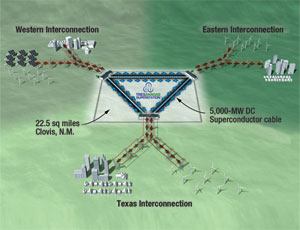A new power-transmission project on the Texas-New Mexico border will facilitate movement of power throughout the U.S. from booming alternative-energy developments in the Southwest. One of those developments, a 600-MW Texas wind farm, will be built with funds and equipment from China. The announcements last month of the two projects strengthens the region’s position as a leader in renewable energy and highlights China’s growing U.S. investment.
The Tres Amigas SuperStation in Clovis, N.M., will link the Texas Interconnection to the nation’s other two electrical grids, the Eastern and Western interconnections. With few connections between them, the isolation of the grids has become a major obstacle to transmitting wind and solar power across the country. Tres Amigas would allow power to be bought, sold and moved among the three sister grids.
China-based Shenyang Power Group and its subsidiary A-Power Energy Generation Systems, along with U.S. Renewable Energy Group, Washington D.C., and Cielo Wind Power LP, Austin, Texas, will develop the wind farm on 36,000 acres in west Texas, with 240 Chinese-manufactured 2.5-MW wind turbines.
Chinese banks will finance the $1.5-billion wind farm, marking China’s entry into the U.S. wind market. The group hopes to receive as much as 30% of its funding from the American Recovery and Reinvestment Act, resulting in 300 construction jobs. The first turbines are to be shipped in March, aiming for operation in 2011.
Tres Amigas will use five- to 10-mile lengths of superconducting underground direct-current cable carrying 5,000 MW to 30,000 MW of electricity. Devens, Mass.-based American Superconductor Corp. (AMSC) will supply the high-temperature superconductor and related equipment. Z Global Inc., Folsom, Calif., is assisting AMSC in the station’s design. The cable has a ceramic conductor cooled by liquid nitrogen.
The cable will be snaked through 3-ft-dia. pipe laid in trenches, says Jason Fredette, AMSC spokesman. These will be the longest superconducting cables yet, and Tres Amigas will be the first station to use superconducting DC cable. The initial 5,000-MW system will require two phases of 8-in.-dia cable.
“Tres Amigas is novel and innovative to me,” says Steve Eckroad, superconductivity program manager at Electric Power Research Institute (EPRI), Palo Alto, Calif. “The superconducting DC cable is probably the only technology that makes [connecting the grids] achievable.”
EPRI next month will publish a report on three and a half years of research into DC superconducting cables. Commercially available DC superconducting cables are several years off, Eckroad says.
Superconducting alternating-current cables have been demonstrated in projects less than a mile long, but more testing is needed on DC cables to determine the most cost-effective way to implement the technologies, Eckroad says. The Tres Amigas station would “jump-start” the use of DC cable, he says.
The hub is being developed by Tres Amigas LLC, Santa Fe, and construction could begin in 2011. Initial costs are estimated to be $500 million to $1 billion. Federal, state and local approvals are still needed.


Post a comment to this article
Report Abusive Comment